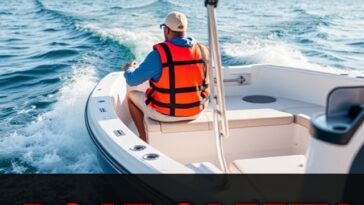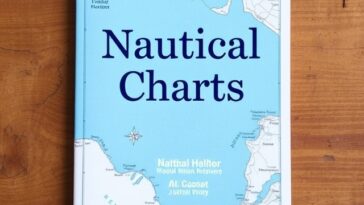A comprehensive glossary of boating nautical terms:
- Abaft: Toward the rear (stern) of the boat.
- Abeam: Alongside the boat, but at right angles to the centerline or keel.
- Aboard: On or in the boat.
- Aft: Toward the rear (stern) of the boat.
- Ahead: Forward of the boat.
- Alee: Away from the direction of the wind.
- Amidships: In or toward the middle of the boat.
- Anchor: A heavy object attached to a boat by a rope or chain, used to hold the boat in place.
- Astern: Behind or toward the rear of the boat.
- Aweigh: The position of an anchor when it has been raised clear of the seabed.
- Ballast: Heavy material placed in the bottom of a boat to improve stability.
- Bar: A ridge of sand, gravel, or other material across the entrance of a harbor or river.
- Batten: A thin strip of wood or plastic used to stiffen sails or covers.
- Beam: The width of a boat at its widest point.
- Bearing: The direction of an object or point relative to the boat.
- Bilge: The lowest part of a boat’s interior where water collects.
- Binnacle: The stand or housing for a ship’s compass.
- Bitter End: The free end of a rope or chain.
- Boat Hook: A pole with a hook on one end, used for grabbing and pulling objects.
- Boatyard: A facility where boats are built, repaired, or stored.
- Bow: The front (forward) part of the boat.
- Bowline: A type of knot used to form a fixed loop at the end of a rope.
- Bowline Knot: A knot used to form a fixed loop at the end of a rope.
- Buoy: A floating marker used for navigation or to mark hazards.
- Cabin: The enclosed area below deck where people can sleep or take shelter.
- Calm: A condition of little or no wind.
- Capsize: To overturn a boat.
- Cast Off: To release a mooring line or dock line.
- Cleat: A fitting on a boat used to secure ropes or lines.
- Coaming: The raised edge around the cockpit or hatch to prevent water from entering.
- Companionway: A staircase or ladder leading from the deck to the cabin.
- Course: The direction in which a boat is steered.
- Cuddy Cabin: A small cabin in the bow of a boat.
- Current: The flow of water in a particular direction.
- Dead Ahead: Directly in front of the boat.
- Dead Astern: Directly behind the boat.
- Dinghy: A small boat often used for transportation between a larger boat and the shore.
- Displacement: The weight of water displaced by a boat’s hull.
- Dock: A structure built along the shore for mooring boats.
- Draft: The depth of a boat’s hull below the waterline.
- Ebb Tide: The outgoing or falling tide.
- ESD: Electric shock drowning. (electricshockdrowning.org)
- Fairlead: A fitting used to guide a line in a specific direction.
- Fathom: A unit of measurement equal to six feet, used to measure water depth.
- Fender: A cushioning device used to protect a boat from damage when docking or mooring.
- Ferry: A boat used to transport people, vehicles, or goods across a body of water.
- Flag: A piece of cloth with a distinctive design or symbol used as a signal or decoration.
- Flare: A pyrotechnic device used as a distress signal.
- Fluke: The pointed part of an anchor that digs into the seabed.
- Forecastle: The forward part of a boat’s deck.
- Forward: Toward the front (bow) of the boat.
- Galley: The kitchen area of a boat.
- Gangway: A temporary bridge or passage used for boarding or disembarking a boat.
- Ground Tackle: Equipment used for anchoring a boat, including anchor, chain, and rode.
- Gunwale: The upper edge of the side of a boat.
- Halyard: A line used to hoist or lower a sail.
- Handrail: A railing used to provide stability and support while moving around the boat.
- Hatch: An opening in the deck or cabin used for access or ventilation.
- Head: The toilet or bathroom area on a boat.
- Heading: The direction in which a boat is pointed.
- Heave To: To stop a boat’s forward motion and stabilize it in rough seas.
- Helm: The steering mechanism or control station on a boat.
- Hull: The main body of a boat, excluding masts, sails, and superstructure.
- Inboard: Located within the hull of the boat.
- Inboard Motor: A motor located within the hull of the boat.
- Jib: A triangular sail located forward of the mast.
- Jibe: To change the direction of a boat by turning the stern through the wind.
- Jury Rig: A temporary or makeshift rigging or repair.
- Keel: The centerline of a boat’s hull that extends below the waterline for stability.
- Knot: A unit of speed equal to one nautical mile per hour.
- Lanyard: A short line or cord used to secure objects.
- Lateral Mark: A navigational marker indicating the edges of a channel or fairway.
- Leeward: Away from the direction of the wind.
- Lee Shore: The side of the shore that is sheltered from the wind.
- Life Jacket: A buoyant device worn to keep a person afloat in the water.
- Lifeline: A line or cable rigged around the perimeter of a boat for safety.
- Log: A record of a boat’s speed, direction, and distance traveled.
- Mainmast: The tallest mast on a boat.
- Mainsail: The primary sail located aft of the mainmast.
- Mainsheet: A line used to control the angle of the mainsail.
- Marina: A facility with docks, moorings, and other amenities for boats and boaters.
- Mast: A vertical pole or spar that supports sails.
- Mooring: A place where a boat can be secured, often with a buoy or anchor.
- Mooring Buoy: A floating buoy to which boats can be secured.
- Navigation: The process of planning and controlling the movement of a boat.
- Navigation Lights: Lights used to indicate the position and direction of a boat at night.
- Outboard: Located outside the hull of the boat.
- Outboard Motor: A motor mounted on the transom of a boat.
- Outhaul: A line used to adjust the tension on the foot of a sail.
- Overboard: Over the side of the boat and into the water.
- Paddle: A handheld device used to propel a small boat through the water.
- Painter: A line attached to the bow of a small boat for towing or securing.
- PFD: Personal Flotation Device; a buoyant device worn to keep a person afloat in the water.
- Pier: A structure built out from the shore for mooring boats.
- Pilot: A person who navigates and controls a boat.
- Pilothouse: An enclosed area on a boat from which it can be navigated.
- Pivot: The point around which a boat turns.
- Poop Deck: The highest deck at the rear of a ship, usually above the main deck.
- Port: The left side of the boat when facing forward.
- Portside: The left side of the boat when facing forward.
- Propeller: A rotating device with blades used to propel a boat through the water.
- Prow: The forward part of a boat’s hull.
- Quarter: The rear part of a boat’s side.
- Radar: A device that uses radio waves to detect objects and determine their position.
- Railing: A barrier or guardrail around the edge of a boat’s deck.
- Ramp: A sloping surface used for boarding or disembarking a boat.
- Reef: A portion of a sail that is folded or rolled up to reduce its area.
- Reefing: The process of reducing the area of a sail by folding or rolling it up.
- Rigging: The system of ropes and cables used to support and control the sails.
- Ripple: A small wave or series of waves on the surface of the water.
- Rope: A length of fibers, strands, or wires twisted or braided together.
- Rowlock: A device on a boat’s gunwale for holding an oar in place.
- Rudder: A movable device used to steer a boat.
- Running Rigging: The lines used to control the sails and other moving parts of a boat.
- Sailing: The activity of traveling in a boat using sails.
- Sailing Directions: Navigational guides containing information about specific areas of water.
- Sailing Vessel: A boat powered primarily by wind.
- Scupper: A hole or opening in the side of a boat for draining water from the deck.
- Sea Anchor: A device used to stabilize a boat in rough seas.
- Seaworthy: Fit for traveling on the sea; capable of withstanding the rigors of the ocean.
- Sextant: A navigational instrument used to determine the angle between celestial objects and the horizon.
- Sheet: A line used to control the angle of a sail relative to the wind.
- Shoal: A shallow area of water, especially one that is a hazard to navigation.
- Shore: The land along the edge of a body of water.
- Shoreline: The boundary between land and water.
- Sloop: A sailing vessel with a single mast and a fore-and-aft rig.
- Spar: A pole or mast used to support sails or rigging.
- Spinnaker: A large, lightweight sail used for sailing downwind.
- Spring Line: A mooring line used to prevent a boat from moving forward or backward.
- Spritsail: A four-sided sail suspended from a boom and a sprit.
- Squall: A sudden, violent gust of wind, often accompanied by rain or hail.
- Starboard: The right side of the boat when facing forward.
- Starboard Side: The right side of the boat when facing forward.
- Steerage: The ability to steer and control the movement of a boat.
- Stern: The rear (back) part of a boat.
- Stern Anchor: An anchor deployed from the stern of a boat to prevent it from swinging.
- Tack: The lower forward corner of a sail.
- Tacking: Changing the direction of a boat by turning the bow through the wind.
- Tackle: A system of ropes and pulleys used to lift or move heavy objects.
- Tide: The rise and fall of the sea level caused by gravitational forces.
- Tiller: A lever used to steer a boat.
- Topside: The upper part of a boat’s hull.
- Transom: The flat or slightly curved rear part of a boat’s hull.
- Trim: Adjusting the balance and angle of a boat to optimize its performance.
- Truck: The top of a mast where the flag is flown.
- Turnbuckle: A device used to adjust the tension on rigging or cables.
- Underway: In motion; moving through the water.
- Upwind: Against or into the direction of the wind.
- Wake: The waves and turbulence left behind a moving boat.
- Waterline: The line where the hull of a boat meets the surface of the water.
- Way: The movement or progress of a boat through the water.
- Weather Deck: The upper deck of a boat exposed to the weather.
- Weather Helm: The tendency of a boat to turn into the wind.
- Weather Side: The side of the boat exposed to the wind.
- Well Deck: A lower deck on a boat that is open to the weather.
- Wheelhouse: An enclosed area on a boat where the steering wheel and controls are located.
- Whisker Pole: A pole used to hold out the clew of a jib or staysail when sailing downwind.
- Windlass: A mechanical device used for raising and lowering heavy objects, such as an anchor.
- Windward: The direction from which the wind is blowing.
- Winch: A mechanical device used to raise or lower sails or anchor.
- Yacht: A large recreational boat, often used for cruising or racing.
- Yardarm: The horizontal spar or beam on a mast from which a sail is hung.
- Yaw: To deviate from a straight course due to wind or waves.
- Zephyr: A light, gentle breeze.
This glossary covers a wide range of nautical terms used in boating, from basic anatomy to navigation and safety equipment. Understanding these terms can enhance your knowledge and enjoyment of boating activities.





 No products in the cart.
No products in the cart.